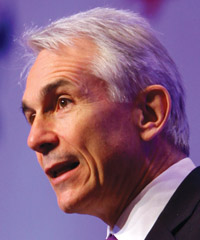That was the message in a nutshell at the 68th International Air Transport Association (IATA) annual general meeting and world transport summit, held in Beijing last month. But throughout it all, the Asia-Pacific is standing strongest
Full report by TOM BALLANTYNE
| |
 |
| |
'A few months ago, an oil price crisis was the biggest risk. Now all eyes are back on Europe. The industry’s profitability is on a knife edge' |
| |
Tony Tyler
Director General
IATA |
| |
|
Last year’s news was bad at the IATA annual meeting. This year’s news was even worse.
More than 700 airline chiefs and industry executives focused on familiar themes; the vagaries of the fuel price, the verbal fisticuffs between the European Union (EU) and the rest of the world over its controversial emissions trading scheme (ETS), the economic turmoil, particularly in Europe, that is affecting the industry and ways to stop greedy governments from treating aviation as a cash cow with its taxes and charges.
But it was statistics that brought home to one of the world’s most highly capitalized industries the fine line it is treading. After reaching a record $15.8 billion profit two years ago, with a net profit margin of 2.9%, the industry is forecast to slump to a $3 billion profit this year with a 0.5% net margin.
But as the dark clouds rolled by one constant shone through – the strength of the industry in the Asia-Pacific. It’s true that bottom lines were not as buoyant as last year, but the region is still expected to record a $2 billion net profit for 2012, more than 66% of the total global profits.
Little wonder that the Asia-Pacific, driven by the powerhouse that is China, is regarded as number one in the world for growth in the aviation industry and all projections point to the gap widening in the years ahead.
It was perhaps significant that this year’s AGM was held in Beijing. The Chinese airlines and their executives were out in force and active at all levels, not always the case in the past. They were certainly taking no prisoners when it came to discussing the EU’s ETS. “We will not provide [the EU] with [emissions] data,” said the secretary general of the China Air Transport Association, Wei Zhenzhong.
But the scene was set by IATA director general and former Cathay Pacific Airways chief executive, Tony Tyler, with his state of the industry address. He has impressed in his first year and earned praise from some of those hardest to please. These included some of the Gulf carriers who last year complained of a lack of transparency in the way IATA conducted its business.
There have been a number of wide ranging changes within the association. But in the industry at large the problems remain the same.
| |
 |
| |
Liu Shaoyong, chairman China Eastern Airlines: China has one of the most open markets in the world for foreign businesses |
| |
|
Tyler told the annual general meeting that the industry was fragile. The crisis in Europe was now a bigger concern among airlines than rising oil prices.
“In the last decade, airline revenues totalled $4.6 trillion. We were among the world’s fastest growing industries. But our best annual profit margin of the century so far was 2.9%. And the overall result has been a net loss of $16 billion,” he said.
“2012 is another challenging year. We expect revenues of $631 billion, but a profit of just $3 billion. That’s a 0.5% net margin …and that projection comes with some serious downside risks.”
IATA’s latest revised industry outlook for this year, released by IATA chief economist Brian Pearce, said a fall in oil prices, stronger than expected growth in passenger traffic and a bottoming out of the freight market were driving some improvements in the profitability outlook.
“However, this is offset by the continued and deepening European sovereign debt crisis, which has led markets to expect a further deterioration and damage to economic growth, the adverse impact of which has been built into this forecast,” said Pearce.
It means operators are facing the second year of declining returns since airline profits peaked in 2010 at $15.8 billion, with a net profit margin of 2.9%. This year’s expected poor return was preceded, in 2011, by a year when industry profits fell to $7.9 billion for a 1.3% net profit margin.
The outlook for European, Asia-Pacific and Middle Eastern carriers has been downgraded. According to the forecast, the Asia-Pacific airlines will still make the largest contribution, some $2 billion, to industry profits, although there has been a $0.3 billion downgrade from the previous outlook due to a weak first quarter performance.
This is less than half the $4.9 billion profit that the region delivered in 2011 and a quarter of the $8 billion achieved in 2010.
Asian carriers make up about 40% of the global air cargo business and the weakness of this market in 2011 was the reason why there was a large decline in the region’s profits. There has been little sign of the region’s airlines benefitting from the modest upturn in cargo markets this year although China Airlines president, Sun Huang-Hsiang, did express confidence the slow cargo market has bottomed out and was set to rebound.
| |
 |
| |
'Our [cargo] outlook for the year is cautiously optimistic |
| |
Sun Huang-Hsiang
President
China Airlines |
| |
|
“Our outlook for the year is cautiously optimistic. The worst case scenario is if the fuel price goes up and cargo comes down. But that will affect all airlines since we are all in the same boat,” he said.
However, IATA’s forecast said the slowdown in the Chinese and Indian economies is another factor in the slow growth environment. Nevertheless, it believes the region will benefit from stronger growth in aggregate passenger and cargo traffic this year, as a result of the rebound in demand in the Japanese market after the tsunami and earthquake last year.
“Regional demand is expected to grow at 3.9%, above the anticipated 3.3% growth in capacity, providing some protection to airline profits,” said the forecast.
In Beijing, the single most worrying issue for airline chiefs was undoubtedly Europe’s fragile economic situation. IATA’s revised forecast was based on a weaker European economic environment than previously forecast in March. But the forecast assumes that the worsening of the Eurozone situation is limited and does not deteriorate into a widespread banking crisis, something that is far from assured.
It also assumes the U.S. economy continues to recover, but at a mediocre pace, and that Chinese economic growth slows with a hard landing avoided by policy stimulus.
Pearce warned if the recession swept across Europe, there was a serious risk to the financial viability of some airlines. “We have seen some airlines go out of business and there is a clear possibility it will continue,” said Pearce.
He made it clear all the risks to the forecast are primarily on the downside. “While the forecast is built on the market’s expectation that the sovereign debt crisis in the Eurozone will intensify, the risk of more severe economic weakness in the event of a broader Eurozone banking crisis could easily wipe out industry profits,” he said.
“Similarly, the recent softening in oil prices could easily reverse should the ongoing dispute with Iran deteriorate, causing fears of a disruption in oil supply to resurface.”
Nevertheless, Cathay Pacific chief executive, John Slosar, hoped the recent drop in oil prices would provide some relief to airlines around the world.
IATA offers a reality check
IATA director general, Tony Tyler, made it clear at the annual meeting he won’t be giving up on the fight to eliminate costly taxes and charges such as the UK’s Air Passenger Duty (APD) which has grown from $520 million in 1995 to $4.1 billion today. Or the recent 346% hike in airport charges at India’s Delhi airport. Also being challenged are a 161% increase in airport charges and a 70% increase for air navigation fees in South Africa.
Tyler is leading a major new campaign to convince governments around the world lower taxes and charges are good, not just for airlines, but national economies, trade and jobs growth. |
Cathay recently issued a profit warning to its shareholders, moved to reduce capacity on long-haul routes and retire older B747-400 aircraft sooner than expected. “Very positively, we have seen a real move down in the oil price. That will be better for aviation, but a lot better for the world economy,” said Slosar.
Tyler said there had been no let-up in the volatility of the economic environment. “A few months ago, an oil price crisis was the biggest risk. Now all eyes are back on Europe. The next months are critical and the implications are big,” he said.
“The industry’s profitability is on knife edge. If the bottom line worsens by even the equivalent of just 1% of revenue, our $3 billion profit very quickly becomes a $3 billion loss.”
One reason the Beijing AGM attracted so many delegates – it was also covered by 350 media – was the huge interest among foreign airlines in the potential of the Chinese market. While the country’s economy has slowed it is still growing way ahead of any other market.
IATA organized a panel on “Doing Business in China”. Liu Shaoyong, chairman of China Eastern Airlines, who was on the panel, said executives of any foreign carrier only needed to place themselves at a railway station in China to give them good reason why they should enter the Chinese market.
China was among the countries in the world with the most open markets for foreign businesses, he said.
Next year’s 69th IATA AGM will be held in Cape Town, South Africa.
| Reprint From Orient Aviation |
|

